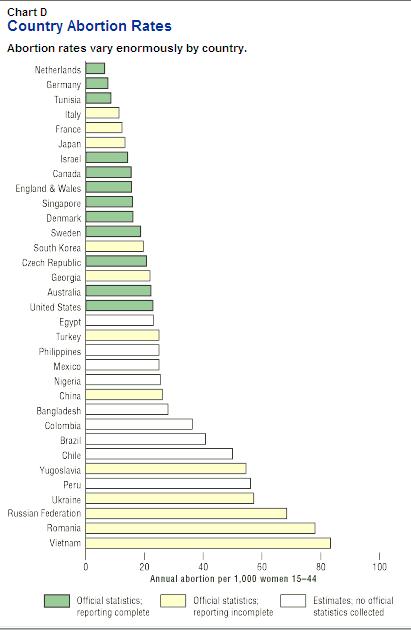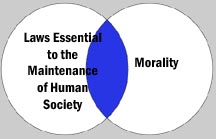The story thus far — in the last post, we learned that Americans opposed to legal abortion have wildly unrealistic notions about what might happen if abortions became illegal. That means it’s up to us in the reality biz to face some facts.
And one of the facts we need to face is that if abortion becomes illegal women who abort will very likely face legal prosecution for it — possibly even homicide charges — in spite of what the Fetus People claim.
Allegedly the recently passed South Dakota abortion ban provides only for the punishment of abortion providers, not the women who abort. From the law:
Section 2. That chapter 22-17 be amended by adding thereto a NEW SECTION to read as follows:
No person may knowingly administer to, prescribe for, or procure for, or sell to any pregnant woman any medicine, drug, or other substance with the specific intent of causing or abetting the termination of the life of an unborn human being. No person may knowingly use or employ any instrument or procedure upon a pregnant woman with the specific intent of causing or abetting the termination of the life of an unborn human being.
Any violation of this section is a Class 5 felony.
What if a woman uses or employs an instrument or procedure upon herself? Wouldn’t that be a violation?
In the last post I mentioned a couple of young women in Colombia who aborted by taking an ulcer medication. They were arrested after being treated in a hospital emergency room for bleeding. Under the SD statute as I read it, whoever sold them the ulcer medication was liable, but it’s not clear to me that the young women wouldn’t have been liable also, since they medicated themselves. Perhaps someone with a legal background could comment on that.
But here’s another wrinkle: In Monday’s Houston Chronicle, Lynn Paltrow and Charon Asetoyer argue that
If the unborn are legal persons, as numerous South Dakota laws assert, then a pregnant woman who has an abortion can be prosecuted as a murderer under already existing homicide laws.
In other words, just because the abortion law itself doesn’t provide a legal liability for the mother doesn’t mean she wouldn’t be liable under another statute.
Farfetched? Not at all.
Prosecutors all over the country have been experimenting with this approach for years. In South Carolina, Regina McKnight is serving a 12-year sentence for homicide by child abuse. Why? Because she suffered an unintentional stillbirth. The prosecutors said she caused the stillbirth by using cocaine, yet, they did not charge her with having an illegal abortion — a crime that in South Carolina has a three-year sentence. Rather, they charged and convicted her of homicide — a crime with a 20- year sentence. They obtained this conviction in spite of evidence that McKnight’s stillbirth was caused by an infection.
Thus far, South Carolina is the only state whose courts have upheld the legitimacy of such prosecutions. But in fact, women in states across the country, including South Dakota, have already been arrested as child abusers or murderers — without any new legislation authorizing such arrests. In Oklahoma, Teresa Hernandez is sitting in jail on first-degree murder charges for having suffered an unintentional stillbirth. In Utah, a woman was charged with murder based on the claim that she caused a stillbirth by refusing to have a C-section earlier in her pregnancy.
If women are now being arrested as murderers for having suffered unintentional stillbirths, one should assume that in South Dakota’s post-Roe world intentional abortions would be punished just as seriously.
Yesterday in Slate William Saletan pointed out that the South Dakota law goes to great length to define a fertilized ovum as an “unborn human being.” Be warned.
Nicholas Kristof’s New York Times column of April 7, 2004 (via Planned Parenthood of the Inland Northwest) provides a glimpse of abortion law enforcement in Portugal.
To understand what might happen in America if President Bush gets his way with the Supreme Court, consider recent events in Portugal.
Seven women were tried this year in the northern Portuguese fishing community of Aveiro for getting abortions. They were prosecuted — facing three-year prison sentences — along with 10 ”accomplices,” including husbands, boyfriends, parents and a taxi driver who had taken a pregnant woman to a clinic.
The police staked out gynecological clinics and investigated those who emerged looking as if they might have had abortions because they looked particularly pale, weak or upset. At the trial, the most intimate aspects of their gynecological history were revealed.
Think that can’t happen here? Remember a year ago, when the attorney general of Kansas subpoenaed abortion clinics for patients’ medical records? The Red State Chastity Police do not have much in the way of respect for privacy.
Kristof continues,
This was the second such mass abortion trial lately in Portugal. The previous one involved 42 defendants, including a girl who had been 16 at the time of the alleged abortion.
Both trials ended in acquittals, except for a nurse who was sentenced to eight and a half years in prison for performing abortions. …
… Portugal offers a couple of sobering lessons for Americans who, like Mr. Bush, aim to overturn Roe v. Wade.
The first is that abortion laws are very difficult to enforce in a world as mobile as ours. Some 20,000 Portuguese women still get abortions each year, mostly by crossing the border into Spain. In the U.S., where an overturn of Roe v. Wade would probably mean bans on abortion only in a patchwork of Bible Belt states, pregnant women would travel to places like New York, California and Illinois for their abortions.
The second is that if states did criminalize abortion, they would face a backlash as the public focus shifted from the fetus to the woman. ”The fundamentalists have lost the debate” in Portugal, said Helena Pinto, president of UMAR, a Portuguese abortion rights group. ”Now the debate has shifted to the rights of women. Do we want to live in a country where women can be in jail for abortion?”
“There’s a growing sense that while abortion may be wrong, criminalization is worse,” Kristof writes. Let’s hope we don’t have to learn that lesson the hard way.
Update: See also Dr. Atrios about an abortion ban advocate who refused to answer a simple question about punishment for the mother who aborts.


 The realm of morality, however, is separate from the realm of legality. There are all manner of things that we might consider immoral that are not, in fact, illegal; adultery is a good example. Such acts may have harmful personal consequences, but regulating them isn’t necessary to civilization. And I don’t see what’s immoral about, say, misjudging how many coins you should put in the parking meter. That’s why I tend to see the legal versus moral question on a Venn diagram. The diagram here isn’t entirely accurate since the blue area should be bigger — law and morality intersect more often than they don’t. I’m just saying that answering the moral question of abortion (assuming we ever will) does not tell us whether an act should be legal or not. In fact, since abortion is legal (with varying restrictions) in most democratic nations today with no discernible damage to civilization itself, I’d say the abortion question falls outside the blue area of the diagram.
The realm of morality, however, is separate from the realm of legality. There are all manner of things that we might consider immoral that are not, in fact, illegal; adultery is a good example. Such acts may have harmful personal consequences, but regulating them isn’t necessary to civilization. And I don’t see what’s immoral about, say, misjudging how many coins you should put in the parking meter. That’s why I tend to see the legal versus moral question on a Venn diagram. The diagram here isn’t entirely accurate since the blue area should be bigger — law and morality intersect more often than they don’t. I’m just saying that answering the moral question of abortion (assuming we ever will) does not tell us whether an act should be legal or not. In fact, since abortion is legal (with varying restrictions) in most democratic nations today with no discernible damage to civilization itself, I’d say the abortion question falls outside the blue area of the diagram. Life Magazine ran its famous photographs of fetii in utero in April 1966. These photos and others like them have been around for 40 years. And the dingbats are talking about better sonograms?
Life Magazine ran its famous photographs of fetii in utero in April 1966. These photos and others like them have been around for 40 years. And the dingbats are talking about better sonograms?